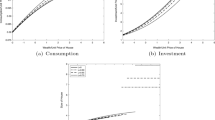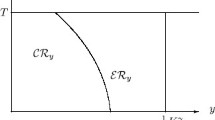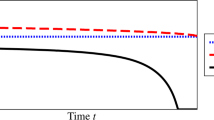Abstract
We characterize the optimal time to purchase a house by a risk-averse investor who has access to complete financial markets and whose objective is to maximize expected utility from wealth at some fixed horizon. The house purchase is financially attractive (due to high expected returns or tax deductions, for example), which provides an incentive to buy as soon as possible; however, its value is only partially correlated with financial markets and, therefore, its price risk cannot be perfectly hedged, which provides an incentive to delay purchase. Using martingale duality method, we fully characterize the optimal terminal wealth in the case of CARA utility, so that we can generate simple numerical solutions for different parameter values, and study the trade-off between the two conflicting incentives. We derive more explicit results when the price follows a Gaussian process. In particular, we identify conditions under which an optimal stopping time is deterministic.





Similar content being viewed by others
Notes
According to the US Census, in 2009 about 2/3 of occupied homes were occupied by their owner. This is in line with rates for other developing countries.
Unfortunately, the martingale duality method doesn’t seem to work when \(I(.)\) is also correlated with \(W^{2}.\)
See, for example, Schachermayer and Teichmann [20] for a similar result in comparing these two models in an option pricing application.
This is straightforward when we have an explicit expression for the Malliavin derivatives, as in the case of deterministic coefficients. Otherwise, it would also be possible to approximate numerically the Malliavin derivatives following the method described in [7].
References
Bhamra, H., Uppal, R.: The effect of introducing a non-redundant derivative on the volatility of stock-market returns when agents differ in risk-aversion. Rev. Financ. Stud. 22, 2303–2330 (2009)
Brendle, S., Carmona, R.: Hedging in partially observable markets. Preprint (2004)
Cauley, S.D., Pavlov, A.D., Schwartz, E.S.: Homeownership as a constraint on asset allocation. J. Real Estate Financ. Econ. 34, 283–311 (2005)
Cocco, J.F.: Portfolio choice in the presence of housing. Rev. Financ. Stud. 18(2), 535–567 (2005)
Cocco, J.F., Gomez, F.J., Maenhout, P.J.: Consumption and portfolio choice over the life-cycle. Rev. Financ. Stud. 18(2), 491–533 (2005)
Cvitanić, J., Schachermayer, W., Wang, H.: Utility maximization in incomplete markets with random endowment. Financ. Stoch. 2, 718–767 (2001)
Cvitanić, J., Goukasian, L., Zapatero, F.: Monte Carlo computation of optimal portfolios in complete markets. J. Econ. Dyn. Control 27, 971–986 (2003)
Detemple, J., Zapatero, F.: Asset prices in an exchange economy with habit formation. Econometrica 59, 1633–1657 (1991)
Detemple, J., Garcia, R., Rindisbacher, M.: A Monte Carlo method for optimal portfolios. J. Financ. 58, 401–446 (2003)
Flavin, M., Yamashita, T.: Owner-occupied housing and the composition of the household portfolio over the life cycle. Am. Econ. Rev. 92, 345–362 (2002)
Frei, C., Schweizer, M.: Exponential utility indifference valuation in two Brownian setting with stochastic correlation. Adv. Appl. Prob. 40, 401–423 (2008)
Grossman, S.J., Laroque, G.: Asset pricing and optimal portfolio choice in the presence of illiquid durable consumption goods. Econometrica 58, 25–51 (1990)
Hugonnier, J., Morellec, E.: Corporate control and real investment in incomplete markets. J. Econ. Dyn. Control 31(5), 1781–1800 (2007)
Karatzas, I., Shreve, S.E.: Methods of Mathematical Finance. Springer, Berlin (1998)
Karatzas, I., Wang, : Utility maximization with discretionary stopping. SIAM J. Control Optim. 39, 306–329 (2001)
Miao, J., Wang, N.: Investment, consumption, and hedging under incomplete markets. J. Financ. Econ. 86, 608–642 (2007)
Oberman, A., Zariphopoulou, T.: Pricing early exercise contracts in incomplete markets. Comput. Manag. Sci. 1, 75–107 (2003)
Ocone, D., Karatzas, I.: A generalized Clark representation formula, with application to optimal portfolios. Stoch. Stoch. Rep. 34, 187–220 (1991)
Piazzesi, M., Schneider, M., Tuzel, S.: Housing, consumption and asset pricing. J. Financ. Econ. 83, 531–570 (2007)
Schachermayer, W., Teichmann, J.: How close are the option pricing formulas of Bachelier and Black-Merto-Scholes? Math. Financ. 18(1), 55–76 (2008)
Sinai, T., Souleles, N.: Owner-occupied housing as a hedge against rent risk. NBER Working Paper No. 9462 (2003)
Tebaldi, C., Schwartz, E.: Illiquid assets and optimal portfolio choice. Working paper, UCLA (2007)
Viceira, L.: Optimal portfolio choices for long-horizon investors with nontradable labor income. J. Financ. 56(2), 433–470 (2001)
Yao, R., Zhang, H.H.: Optimal consumption and portfolio choices with risky housing and borrowing constraint. Rev. Financ. Stud. 18(1), 197–239 (2005)
Author information
Authors and Affiliations
Corresponding author
Appendix
Appendix
Lemma 7
Let \(\tau \) be a stopping time adapted to \(\digamma ^{1}\) and \(l(s,t)\) be as in (3.4) for \(\tau \le s<t\le T\). Moreover, let the processes \(M(.)\) and \(D(.)\) be given by Notation 1. Then
-
(i)
For all \(p\ge 1\), we have \(E\sup \limits _{0\le s<t\le T}\left| l(s,t)\right| ^{p}<\infty \).
-
(ii)
There exists a process \(\phi \in L_{\digamma ^{1}}^{2}[\tau ,T]\) such that
$$\begin{aligned} H(T)&= \frac{1}{a}\left\{ \int \limits _{\tau }^{T}(\phi -b)(t)dW^{1}(t)+\int \limits _{\tau }^{T}\left( \frac{1}{2}|\phi (u)|^{2}-c\right) (t)dt-\ln E_{\tau }[l(\tau ,T)]\right\} \\&-\int \limits _{\tau }^{T}I(u)du \text {, a.s.} \end{aligned}$$ -
(iii)
Similarly, there exists a process \(\psi \in L_{\digamma ^{1}}^{2}[0,\tau ]\) such that \(D(\tau )\) can be written as
$$\begin{aligned} D(\tau )+\int \limits _{0}^{\tau }I(u)du= \frac{1}{a}\left\{ \int \limits _{0}^{\tau }(\psi -b)(t)dW^{1}+\int \limits _{0}^{\tau }\left( \frac{1}{2}\psi ^{2}-c\right) (t)dt-\ln E[M(\tau )]\right\} . \end{aligned}$$
Proof
(i) For \( 0\le s<t\le T\), since the process \(b(t)\) is essentially bounded over \([0,T]\), the process \(M(s,t)=e^{-\int \limits _{s}^{t}b(u)dW^{1}(u)-\frac{1}{2}\int _{s}^{t}b^{2}(u)du}\) is a martingale. Noting that \(0\le a\le \gamma \), \(H(.)\ge 0\), \(c(.)\ge 0\) and \(b(.)\) is bounded, we have \(e^{-paH(t)-p\int _{s}^{t}c(u)du}\le 1\) a.s. and \(e^{\int _{s}^{t} \frac{1}{2}b^{2}(u)du}<K\), for a constant K. Then, by writing the expression \(l(s,t)\) as
we get \(\left| l(s,t) \right| ^{p}\le Ke^{-pa\int _{s}^{t}I(u)du]}M^{p}(s,t)\). Then, by the Cauchy–Schwartz inequality,
The rest of the proof follows by the exponential moment condition on \(I(.)\) and the Burkholder–Davis–Gundy inequality.
(ii) By (the multiplicative form of) the Itô’s Representation Theorem and part (i), there is a (unique) progressively measurable process \(\phi \) such that
Then, by taking the logarithm of both sides and using Eq. (3.4), we get
After rearranging the integrals and solving for \(H\), the result follows. (iii) It is similar to the part (ii) after observing that the process \( M(\tau )\) has a representation
for some \(\psi \in L_{\digamma ^1 }^{2}[0,\tau ]. \square \)
Lemma 8
Let \(\pi ^{*}\) be as in (3.6) for a given \( \tau \in [0,T)\). Then we have
Proof
Let the parameters \(a\), \(b(\cdot )\) and \( c(\cdot )\) be as before. By Eq. (2.2) and Lemma 7 (ii), \( X^{\pi ^{*}}(T)+H(T)\) can be written as
which is equivalent to the right hand side of (6.1) if and only if
Writing \(\phi =\frac{\mu -\gamma (1-\rho ^{2})\sigma ^{2}\pi ^{*}}{\rho \sigma }\) from (3.6), using (3.7) and comparing the drift and diffusion terms in both sides of the Eq. (6.2), the result follows.\(\square \)
Lemma 9
Let \(0\le \tau <T\) be given and \(X(\tau )=x\) be fixed. Then, the followings hold:
-
(i)
The process \(\{\tilde{Z}(\tau ,t)\), \(\tau \le t\le T\}\) is a martingale under \(P\).
-
(ii)
The process \(\{\tilde{W}(t)=W(t)+\int \limits _{\tau }^{t} \sigma ^{Z}(u)du: \tau \le t\le T\}\) is a Brownian motion under \(\tilde{P}\).
-
(iii)
\(X^{\pi }(t)-\int _{\tau }^{t}\) \(I(u)du,\) with \(\tau \le t\le T,\) is a martingale under \(\tilde{P}\) for any admissible portfolio process \(\pi \). In particular, \(\tilde{E}_{\tau }^{\tau ,x}[X^{\pi }(t)-\int \limits _{\tau }^{t} \) \(I(u)du]=x\), for any \(\tau \le t\le T\).
Proof
(i)–(ii) The diffusion vector \(\sigma ^{Z}=[\sigma ^{Z1}\,\sigma ^{Z2}] \) is a square integrable process as a linear function of \(\pi ^* \) (3.7). Hence the proofs follow from the dynamics of \(\tilde{ Z}\) and Girsanov theorem.
(iii) By Itô’s rule,
where the drift term \([\mu -\rho \sigma \sigma ^{Z1}-\sqrt{1-\rho ^{2}}\sigma \sigma ^{Z2}]\) vanishes by (3.7). Then, it is easy to see that
is a square integrable martingale with
\(\square \)
Corollary 6
Assume that all the model parameters are deterministic. Then the process \(\phi \) in the representation of \(\pi ^{*}(t)=\frac{\mu -\rho \sigma \phi }{\gamma (1-\rho ^{2})\sigma ^{2}}(t)\) is given by
where \({\mathcal {D}}\) is the Malliavin derivative operator with respect to \(W^{1}\). Moreover, if the income rate process \(I\) is also deterministic, then
Proof
The random variable \(l(\tau ,T)\) can be written as
where, by the Clark–Ocone formula,
When the parameters are deterministic, \( {\mathcal {D}}_{t}l(\tau ,T) \) can be computed as
Noting that \(\frac{l(\tau ,T)}{l(\tau ,t)}=e^{aH(t)}l(t,T)\), the result follows from (6.6). When \(I(t)\) is deterministic, the Malliavin derivatives vanish and we get (6.4)\(\square \)
Remark 7
The conditional expectations on the right-hand side of (6.3) or (6.4) cannot be solved explicitly. However using Euler discretizations, they can be solved numerically through Monte Carlo simulations, thanks to the conditional Gaussian distribution of the time-discretized processes \(l(t_{i},t_{i+1})\) and \( l(t_{i},t_{i+1})H(t_{i+1}) \) over a partition \(\{ \tau =t_{0}<t_{1}<\cdots <t_{n}=T\}\) of \([\tau ,T]\).Footnote 6
Corollary 7
With the deterministic model parameters, the process \(\psi \) in the representation of \(\pi _{*}(t)= \frac{\mu -\rho \sigma \psi }{\gamma (1-\rho ^{2})\sigma ^{2}}(t)\) is given by \(\psi (t)=-E_{t}[D_{t}M(\tau ]/M(t)\), where
Proof
Again, by the Clark–Ocone formula, \(\psi (t)=-E_{t}[{\mathcal {D}} _{t}M(\tau )]/M(t)\) and
\(\square \)
Lemma 10
Let \(\pi _{*}\) be the optimal portfolio before \(\tau \) as in Corollary 7, and \(X^{\pi }(0) = x_{0}\) . Then,
-
(i)
\(X^{\pi _{*}}(\tau _{-})+D(\tau )=x_{0}- \frac{1}{ \gamma (1-\rho ^{2})}\ln E[M(\tau )]-\frac{1}{\gamma }\ln \tilde{Z} (\tau )\)
-
(ii)
\(-\gamma (\tilde{E}\int \limits _{0}^{\tau }I(u)du+\tilde{E}[D(\tau )])-\tilde{E}[\ln \tilde{Z}(\tau )]=\frac{1}{1-\rho ^{2}} \ln E[M(\tau )]\)
Proof
Using Lemma 7 (iii) and the notation of Definition 1, it is similar to that of Lemma 8.\(\square \)
Lemma 11
Let \(H(t)\) satisfy (5.1) with \(H(0)=h\), \(l(s,t)\) be as in (3.4), and introduce
for \(0\le s\le t\le T\). Then
-
(i)
The expression \(V^{\tau ,x}=\sup \limits _{\pi \in {\mathcal {U}}(\tau ,T)}E_{\tau }^{\tau ,x}[-e^{-\gamma Y(T)}],\) of the problem (3.1) can be written as
$$\begin{aligned} V^{\tau ,x}=-e^{-\gamma x-\frac{1}{1-\rho ^{2}}(\alpha (\tau ,T)-\frac{1}{2} \int _{\tau }^{T}\beta ^{2}(u,T)du)} \end{aligned}$$(6.8)for given \((\tau ,x)\), with \(0\le \tau <T\) and \(x=X(\tau )>0\).
-
(ii)
Let \(\delta (t)\) be a deterministic function on \([0,T]\). Then, for \(0\le s\le t\le T\), the process \(M(\cdot )\) in Notation 1 can be written as \(M(t)=M(s)e^{\xi (s,t)}\) where
$$\begin{aligned} \xi (s,t)&= -a[(1-\delta (s))(H(t)-H(s))-H(t)(\delta (t)-\delta (s))+\int \limits _{s}^{t}I(u)du \nonumber \\&-(h\mu ^{H}+\mu ^{I})(t-s)]-[a\sigma ^{I}(T-t)+b](W^{1}(t) -W^{1}(s))\nonumber \\&-\frac{1}{2} \int \limits _{s}^{t}\beta ^{2}(u,T)du, \end{aligned}$$(6.9)with \(\xi (s,s)=0\) and the constants \(a,b\) and \(c\) are as in (3.3): \(a=\gamma (1-\rho ^{2}),b=\frac{\mu \rho }{\sigma }\) and \(c=\frac{ \mu ^{2} }{2\sigma ^{2}}\).
Proof
(i) Noting that \(\int \limits _{s}^{t}W^{1}(u)du=\int \limits _{s}^{t}(t-u)dW^{1}(u)+W^{1}(s)(t-s)\), we have \(\int \limits _{s}^{t}I(u)du=\int \limits _{s}^{t}\mu ^{I}du+\sigma ^{I}(\int \limits _{s}^{t}(t-u)dW^{1}(u)+W^{1}(s)(t-s))\). Then the exponent term of \(l(s,t)\) in (3.4) with constant parameters reduces to \(-\alpha (s,t)-\int \limits _{s}^{t}\beta (u,t)dW^{1}(u),\) after rearranging the terms involved. Since this expression has a conditional Gaussian distribution (given \(\digamma _{s}\)) with conditional mean \( -\alpha (s,t)\) and variance \( \int \limits _{s}^{t}\beta ^{2}(u,t)du\), we get \(E_{s}[l(s,t)]=e^{-\alpha (s,t)+\frac{1}{2}\int \limits _{s}^{t}\beta ^{2}(u,t)du}\). Then the result follows directly from Theorem 1.
(ii) Note that \(M(t)\) can be written as
where \(I(t)=\mu ^{I}+\sigma ^{I}W^{1}(t)\) and \(E_{t}[l(t,T)]=e^{-\alpha (t,T)+ \frac{1}{2}\int \limits _{t}^{T}\beta ^{2}(u,T)du}\). Then by comparing \(M(t)\) with \(M(s)\), for \(s \le t\) using (6.10), and simplifying the terms in the exponent of the ratio \(M(t)/M(s)\), the result follows.\(\square \)
Rights and permissions
About this article
Cite this article
Cetin, C., Zapatero, F. Optimal acquisition of a partially hedgeable house. Math Finan Econ 9, 123–147 (2015). https://doi.org/10.1007/s11579-014-0137-x
Received:
Accepted:
Published:
Issue Date:
DOI: https://doi.org/10.1007/s11579-014-0137-x




